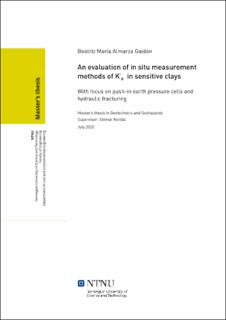| dc.description.abstract | The determination of the in situ stress state within the frame of any geotechnical problem is crucial. The coefficient of earth pressure at rest (K_0^') is an important parameter for numerical analysis and laboratory test design. In situ vertical stress is easily calculated by knowing depth and specific gravity of the material forming the soil. However, the determination the in situ horizontal stress is a challenging task as it has been stated by numerous authors work as found in the literature review fulfilled within this master thesis. The determination of K_0^´ is still a pending task within geotechnical engineering since both in situ or laboratory testing induce, in major or minor degree, a disturbance on the original soil stress state. The repeatability and reliability of the results outcasted by in situ and laboratory methods seems not to be enough.
Hence many efforts have been made to define an empirical relationship between soil parameters, (which determination is reliable by well establish field and laboratory methods) and the coefficient of earth pressure at rest. Nevertheless, it is difficult to define a general expression or equation since there is a high degree of dependence on soil properties and local conditions as stress history or time. The uncertainty is then larger in the case of overconsolidated soils.
A general description of Tiller-Flotten Geo-Test Site is presented. A summary of strength and index parameters from previous work found in literature are summarized and used as input to determine K_0^´ by mean of correlation methods.
Push-in earth pressure cells have been installed to measure lateral total stress as well as in situ pore pressure. Each cell has been installed at the same borehole to draw a profile. In total 4 measurement have been performed, two at 5 m in the overconsolidated Unit IIa, and two at 7.5 m in the transition zone from Unit IIa to Unit IIb where the consolidation grade begins to decrease. The installation of the cells is uncomplicated, and no disturbance of the instrument is observed after removal from ground. In general, in situ lateral stress derived from push-in cells show low scatter and fit well with expected values at investigated depths. Pore pressure registered are close to the in situ estimated pore pressure at that investigation depth, but values may be taken with precaution. Unfortunately, the logging compliance failed at the end of the second installation maybe due to condensation inside the box. The equipment was sent to repair and due to COVID-19 crisis, the repairing of the electronic compliance of push-in earth pressure cells suffered a big delay, precluding the availability of the equipment inside this master thesis schedule. Hence the testing program had to be cancelled. Results from push-in earth pressure cells show that the method is potentially reliable and stable.
Hydraulic fracturing test is presented as a potential method for the in situ measurement of horizontal stress. The literature suggests good results in normally consolidated clay deposits, but no previous experiences are available in Norwegian high sensitive clays. A detailed description of the equipment and the procedure followed during the execution of the test are presented. A deep review of the collected data by the author during spring of 2019 is done. These data were taken at 6 different boreholes with investigation depths going from 5 to 17 m, including a second test attempt at same investigation depth for depths 5, 10 and 15 m. In general, K_0^' obtained by hydraulic fracturing are between 20 and 40% higher than those previously reported from dilatometer, CPTU or by the empirical correlation for Norwegian clays. Those higher values could indicate that perhaps the horizontal stress is not being measured, i.e. no vertical cracks open when injecting the fluid in the ground. Cracks could be opened following weak horizontal or inclined surfaces thus the closing pressured register would not correspond to the horizontal stress.
The hydraulic fracturing set up was modified by adding a new syringe pump to avoid stopping the injection cycling for refilling. Also, two injection spade shaped nozzles (designed at NTNU) were tested, looking to create a preferential vertical plane to contribute to the formation of a vertical crack during the injection. It is difficult to extract any reliable conclusion from results obtained since no evidence of what is the mechanism is taking place around injection nozzles. | |
